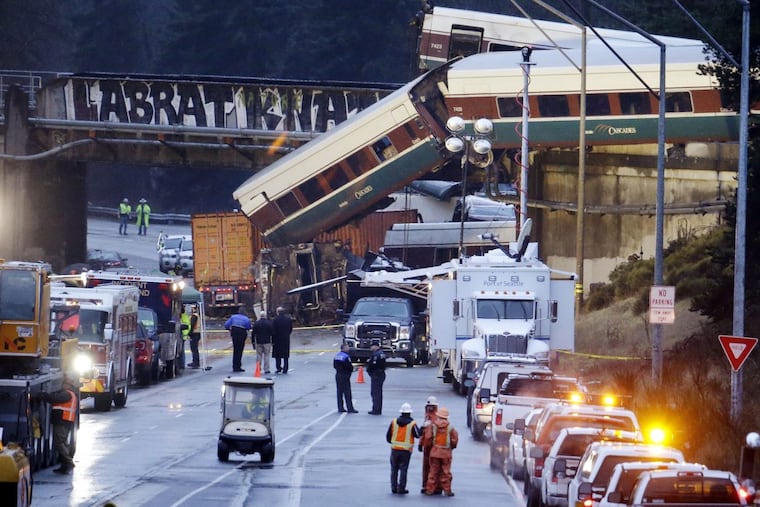Tragic parallels between Washington Amtrak derailment and Philly's are growing
Speed may have been a factor in Washington state's Amtrak derailment. Just like Philly's. And once again, a critical safety system wasn't in place.

A speeding train. An approaching curve. A derailment that took lives.
I wrote Monday that the train derailment in Washington state was a reminder of Philadelphia's own train disaster two years ago, and the latest information only strengthens the unfortunate comparison.
The train that derailed about 40 miles south of Seattle on Monday was going 80 mph on a stretch of track with a 30 mph speed limit in advance of a curve, according to the Seattle Times. Three deaths have been reported.
Sound familiar? On May 12, 2015, Amtrak Train 188 was traveling at 106 mph as it approached a curve in Philadelphia with a 50 mph speed limit. It was one of 276 Amtrak derailments reported in the last 10 years.
There's a lot still to discover about what happened in Washington, and it's too soon to come to any conclusions about the cause of this derailment, but one fact is that a technology exists specifically to slow a train traveling too fast on the rails. Positive Train Control got a lot of attention in Philadelphia two years ago because experts said it would have automatically hit the brakes on Train 188 when the engineer, Brandon Bostian, did not. That would have saved eight lives and scores of injuries. But PTC wasn't in place then. And it apparently wasn't in place in Washington either to slow down Train 501.
That train was the first to travel on a newly upgraded route on the Cascades Line. While the status of PTC installation on that line is unclear, documents from the Washington Department of Transportation show that adding the speed control system was part of the upgrades to the vehicles and track. It wasn't active yet, though.
Here's what the DOT website says:
"This 'next generation' rail equipment features safety upgrades, including on-board positive train control system, which will automatically stop the train when there are dangerous situations on the rails, once the system is activated corridor-wide in 2018."
Both SEPTA and Amtrak's Northeast Corridor have PTC in place. NJ Transit has predicted a 2018 debut for the system on its rail lines. SEPTA and the Southern California Regional Rail Authority are the only railroads in the country, passenger or freight, that have fully installed PTC, the Federal Railroad Administration reported.
Clearly, journalists in Washington state will be digging into why this new route was activated before this critical safety system was ready — Amtrak's CEO Richard Anderson reportedly said the system was still being tested — but a short answer is that it wasn't required. Two years ago, Congress decided to postpone a mandate to have PTC on all freight and passenger railroads from the end of 2015 to 2018, with the possibility of another delay until 2020.
Whether the nation's railroads will have PTC by the new deadline remains an open question. Twenty of the 42 passenger and freight rail lines mandated to have PTC have reported it will be available by the end of 2018. An additional seven reported it will be installed by 2019 or 2020. With a year to go until the next due date, though, the progress reports these railroads have submitted don't look promising. Not quite half of all freight lines have their tracks installed with PTC equipment, and only 20 percent of passenger railroads have the necessary equipment in place, according to FRA data. Passenger railroads nationwide have 41 percent of their locomotives equipped with PTC's technology.
Amtrak, which carries about 31 million people a year, reported 1,263 deaths in the last decade. That includes people on the tracks hit by trains. Last year's deaths — 167 — was the highest number in a decade, though the rate of crashes not at grade crossings is lower than 10 years ago.
The former head of the Federal Railroad Administration, Sarah Feinberg, said PTC was critical when she was running the railroad regulator and wanted to push to have the system installed before 2018.
"PTC just has to be a huge priority and needs to be implemented as soon as possible," she said in May 2016, when she was still running the FRA.
That hasn't happened, though. Congress delayed the PTC mandate because railroads said it would be prohibitively expensive to get it done by the end of 2015. In November 2015, my colleague Jonathan Tamari wrote that railroads anticipated it would cost $12.5 billion to outfit about 70,000 miles of track with PTC. The 2015 deadline was established in 2008, nearly a decade ago, but the railroad industry lobbied Congress for the postponement, citing regulations, technological hurdles, and budget crunches as factors slowing installation, and saying they might have to shut down without an extension.
There was a Cassandra at the time: Sen. Barbara Boxer (D., Calif.). The now-retired senator opposed the extension, but legislators tied the measure to additional, and necessary, money for the highway trust fund, making it a must-pass, Tamari reported. Then they took a voice vote, meaning no legislator was on the record approving a PTC extension that experts said would leave the door open for another deadly crash to happen.
"It is a terrible precedent to place a major safety — I would say rollback, a safety rollback, on a three-week extension of the highway trust fund," Boxer said in 2015.
Based on the latest information out of Washington, it's possible the disaster Boxer predicted has happened.